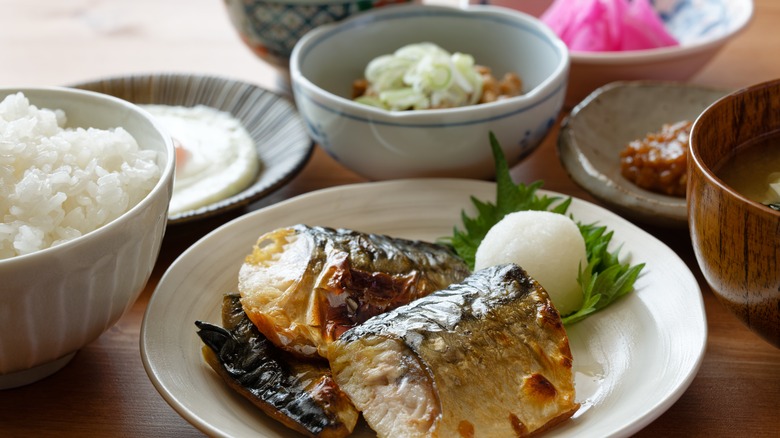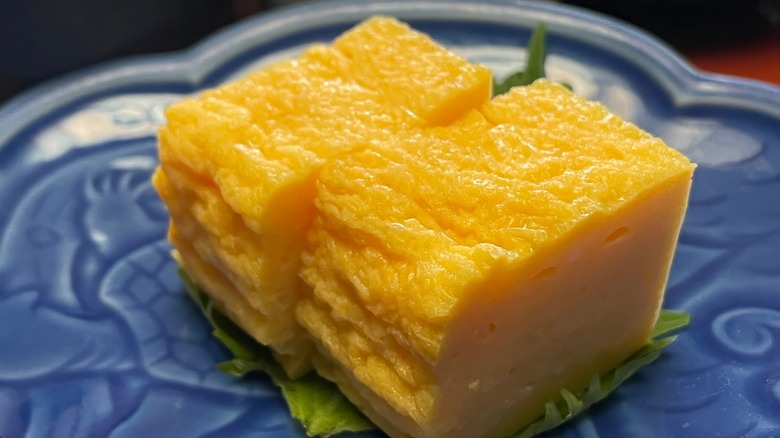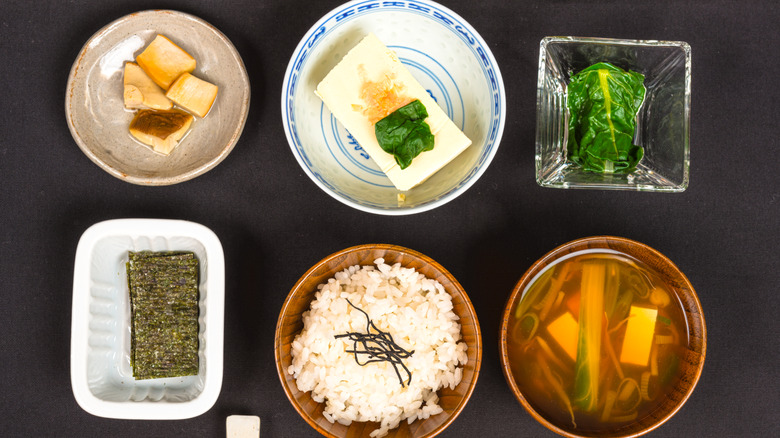Here's What You'd Find In A Traditional Japanese Breakfast
Throughout Europe, North America, and several other parts of the globe, the word "breakfast" usually conjures images of sausage, bacon, scrambled eggs, and various pastries. However, in Japan, few of these foods regularly make an appearance at the breakfast table. While you may see a Japanese rolled omelet on the menu, it's more likely to be accompanied by a range of seafood and rice preparations than sausage and pancakes.
Popular morning seafood choices in Japan include salmon, mackerel, and even sardines. You might enjoy fresh grilled filets drizzled with a little teriyaki sauce, but salt-cured preparations are more common — especially salmon. Called shake (pronounced SHA-keh), salt-cured salmon is frequently stewed or grilled and has an intensely salty, savory flavor.
The Japanese also frequently enjoy soy-based proteins first thing in the morning, such as miso soup and natto. Miso soup features a flavorful combination of cubed tofu, mushrooms, seaweed, and green onions. It can be made from scratch, but there are also many high-quality instant varieties to choose from. Natto is also a low-effort breakfast staple, since these fermented soybeans are readily available in Asian grocery stores. Natto's "funky" flavor is an acquired taste for many, but it's not uncouth to eat it with soy sauce and rice to bring out its nutty undertones and counteract its filmy texture.
Eggs, rice, and veggies (oh, my!)
While eggs are sometimes part of a traditional Japanese breakfast, tamagoyaki — a Japanese rolled omelet — is very different from any omelet you'd find in an American diner. Rather than a half-folded envelope stuffed with cheese and veggies, tamagoyaki eggs are cooked very quickly in a super-thin layer at the bottom of a pan. They're then seasoned with rice wine, soy sauce, and sugar, rolled into a long tube, and sliced into individual portions.
Aside from the abundance of proteins, no Japanese breakfast is complete without rice. Though most people use a rice cooker, it's also fairly easy and quick to make fluffy steamed rice on the stovetop. Brown rice is just as common as white, and both types are usually served plain. The idea is to combine bits of rice with small portions of other dishes to blend flavors, so that each bite is unique.
Japanese breakfasts also feature a variety of veggie dishes. Pickled daikon radish and carrots are often served, and there's a category of side dishes called "kobachi" that includes various types of steamed vegetables and small salads to help round out the flavors and nutrient content of the meal. These may contain broccoli, bell peppers, onions, mushrooms, and much more.
How to eat a Japanese breakfast and what to drink with it
Presentation is a very important part of a traditional Japanese breakfast. Dishes are usually served family-style, with each type of food presented in its own dish. This ensures those eating the meal can easily see what's available. That way, everyone can customize their meal according to personal flavor preferences and appetite level.
Some dishes, such as soup or salad, may already be individually portioned to make serving yourself easier. However, once you've filled your plate, it's expected to combine bites of food from different dishes to experiment with flavors. For instance, you might top a bite of rice with a little salmon or tamagoyaki, or enjoy natto with some pickled daikon. This way, each bite is different, making the meal more interesting.
Despite Japan's long-standing love affair with coffee, it's rare to see this iconic beverage at breakfast. Instead, you'll more likely enjoy a hot cup of green tea to cleanse your palate between savory bites. Whether you prefer loose leaf tea or teabags, it's important to note that matcha is almost never consumed with breakfast. Non-powdered sencha green tea is generally viewed as more appropriate early in the day. That said, some forego a beverage all together, considering the liquid from the miso soup to be enough.


